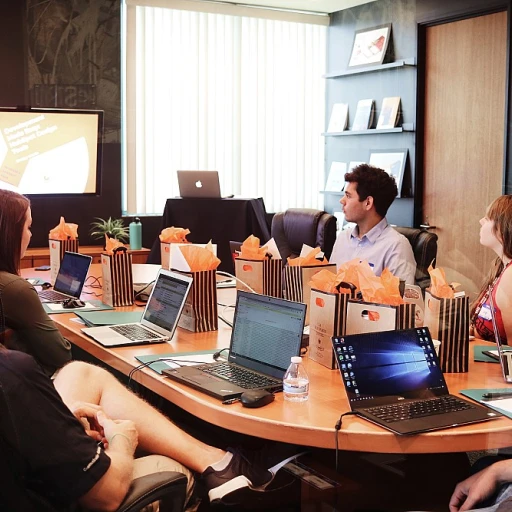Understanding the Importance of Icebreaker Games
The Role of Icebreaker Games in Building Team Dynamics
\nUnderstanding the importance of icebreaker games in a workplace environment is crucial for fostering effective team dynamics. These activities go far beyond mere entertainment; they serve as foundational tools that can enhance communication, create connections, and boost overall employee engagement.\n\nImagine a new team, freshly assembled, with people from diverse backgrounds and experiences. It is essential to help them transition from a collection of individuals to a cohesive unit. This transformation is where icebreaker activities shine. By integrating these into your team building strategy, you can effectively "break the ice" and encourage participants to engage openly with one another.\n\nResearch indicates that when team members feel connected and valued, their productivity and satisfaction significantly increase. This emphasizes the practical need for icebreaker games in the workplace, particularly for groups of various sizes and configurations.\n\nIcebreaker activities are designed to overcome interpersonal barriers, making it easier for each person to contribute and share their ideas comfortably. Whether it is a small group setting with intimate exchange of icebreaker questions or a large gathering with exciting group games, these activities can be tailored to suit the specific dynamics of any team.\n\nFor further insights into how team gatherings can enhance collaboration and communication, read about effective team meetings that improve employee engagement. The link provides valuable strategies to complement your icebreaker efforts, ensuring a comprehensive approach to team development."}Choosing the Right Icebreaker for Your Team
Tailoring the Icebreaker to Your Group's Needs
Selecting the perfect icebreaker activity requires understanding the dynamics of your group. One size does not fit all when it comes to breaking the ice. Consider the group's size, age range, and the time you have available. Icebreaker games that might work well for a small team can lose their impact when dealing with larger groups, and vice versa. First, assess the group size. A scavenger hunt or truths and a lie can work well for both small groups and large gatherings but may need adaptation. For small group activities, offering something like an icebreaker game that encourages each person to share, such as icebreaker questions or the classic two truths and a lie, can be engaging. Students might enjoy a fast-paced fun icebreaker activity, while a more mature team might appreciate something more reflective. It's also important to consider the group's purpose. Are these group members meeting for team building, or is it a more casual get-together? Games that encourage team building help in bonding the group better, while more relaxed games ensure people get familiarized. When choosing an icebreaker, remember that it's not solely about the game itself but also how the activity aligns with the group's objectives. Keeping in mind the participants' needs as well as the group leader's goals will make the icebreaker much more effective. Additionally, think about the time available. Some teams may only have a few minutes to spare at the start of a meeting, while others might dedicate longer sessions solely for icebreaker activities. Being mindful of time helps in selecting games that fit seamlessly into the intended schedule. Finally, don't shy away from exploring icebreaker games that suit your specific context and environment. Whether in-person or virtual, the right game has the potential to elevate engagement levels significantly. For more inspiration and ideas, consider checking out resources dedicated to engaging adults with icebreaker questions. By understanding your group, you can choose an icebreaker that will facilitate a successful interaction and help participants feel more connected.Top Icebreaker Games for Small Teams
Break the Ice with These Engaging Games for Tight-Knit Teams
When working with a small group, the dynamics differ significantly from larger assemblies. You have the advantage of intimacy and focused interaction, making it easier to foster closer connections among participants. With the right selection, icebreaker games can spark engagement, boost team morale, and create lasting bonds. Here, we outline some top activities tailored for small teams.
- Two Truths and a Lie: This classic icebreaker requires minimal preparation yet promises maximum fun. Each team member shares three statements about themselves: two truths and one lie. The group then guesses the false statement. This game not only entertains but also offers insights into individual personalities.
- Scavenger Hunt: Although traditionally seen as a large-group activity, a scavenger hunt can be adapted for intimate settings. Tailor the list of items or clues to your office environment or a specific theme. This activity encourages collaboration and creativity among team members.
- Human Knot: Engage your team with this physically interactive game. Stand in a circle, and each person grabs hands with two different people across from them. The aim is to untangle the human knot without letting go. It’s a great way to develop communication skills and laugh together.
- Quick Questions: Use a list of fun icebreaker questions to prompt discussions among team members. Each person answers a different question, enabling participants to learn unique aspects about each other's interests and experiences.
Choosing the right icebreaker games for your team requires consideration of the group's personality, preferences, and time constraints. When effectively executed, these activities will leave your team more connected, engaged, and ready to tackle challenges together. For more insights, lighten the workplace mood with humorous employee appreciation quotes.
Icebreaker Activities for Large Groups
Engaging Large Groups with Icebreaker Activities
When it comes to engaging large groups, especially in a corporate setting, icebreaker activities offer a dynamic way to ease introductions and foster team cohesion. The objective is to ensure that everyone gets to connect, regardless of the group's size or the diversity of its members. Considerations for Large Groups:- Time Management: Given the larger number of participants, it's crucial to select activities that can be completed within a reasonable time frame without losing momentum.
- Clear Instructions: Ensure that instructions are communicated clearly and concisely. This will help participants grasp the game's flow quickly and engage meaningfully.
- Inclusivity: Choose activities that are suitable for a broad age group and skill level, making everyone feel included and comfortable.
- Team Dynamics: Keep in mind that large groups may have varying levels of acquaintance among participants. Activities that encourage collaboration are beneficial to build a strong sense of teamwork.
- Human Bingo:
- Before the session, prepare bingo cards with various traits or experiences (e.g., "Someone who has worked here over ten years" or "Person who speaks two languages").
- Participants mingle to fill out their cards, which sparks conversations and connections.
- The Scavenger Hunt:
- Split the group into smaller teams and provide a list of items or challenges that must be completed within a time limit.
- This activity promotes collaboration, quick decision-making, and encourages team building across different departments.
- Two Truths and a Lie:
- Each participant shares three statements about themselves – two true and one lie. The group then guesses which statement is false.
- This light-hearted game allows people to discover unexpected facts about each other, breaking barriers and fostering open communication.
- Group Painting:
- Provide a large canvas and art supplies. Each group member contributes to a collective artwork without talking to one another.
- This silent game promotes creativity and demonstrates the value of non-verbal communication within teams.
- Piece of Paper Questions:
- Hand out papers with fun icebreaker questions. Participants form groups and discuss their answers among themselves.
- This encourages conversation and helps team members learn more about each other beyond work-related topics.
Virtual Icebreaker Games for Remote Teams
Interactive Virtual Icebreakers to Build Connection
With the rise in remote work, maintaining team spirit and connectivity has become a significant consideration for many organizations. Virtual icebreaker games offer an excellent opportunity to bridge the gap between separated team members. Rather than letting distance be a barrier, these activities act as a conduit for open communication and team building. Organizing well-planned virtual icebreakers can foster a sense of unity and warmth. When choosing an icebreaker activity, consider the group size, time constraints, and the potential for personalization. For smaller teams, creating more interactive sessions where every person can participate equally may be effective, while larger groups might benefit from concise icebreaker questions. Common virtual icebreakers include the online scavenger hunt, where participants search for items around their home environment and share them during the call. This creates an engaging and relaxed atmosphere, breaking the ice and fostering camaraderie. Another popular game is "Two Truths and a Lie," allowing group members to reveal fun or surprising facts about themselves. The "piece of paper" challenge encourages creativity by asking participants to design or write something related to a shared theme, which works well to break ice and trigger further conversations. By implementing these virtual icebreaker games, organizations can maintain and nurture an engaging team environment, even remotely. The fun element inherent in these activities often results in increased attentiveness and willingness among team members, proving that distance does not necessarily diminish team vibrancy. Moreover, leveraging the connection-building potential of such games represents a proactive approach to sustaining employee engagement during virtual gatherings.Measuring the Impact of Icebreaker Games on Employee Engagement
Assessing the Impact on Team Dynamics
Measuring the success of icebreaker activities is crucial to understanding their impact on employee engagement. While some games might be just for fun, the ultimate goal is to positively influence team dynamics and cooperation among team members. One approach to measuring impact is through feedback and observation. After conducting a lively scavenger hunt or a revealing truths and lie session, gather participants' feedback. You can use icebreaker questions in survey form to understand how the activities were perceived and if they effectively helped to break the ice in the group.Feedback Collection Methods
- Surveys and Questionnaires: Distribute short surveys among participants. Ask questions about how comfortable they felt during the activity, their levels of engagement, and if they found it easy to start conversations.
- Observational Insights: Observe the team's interactions post-activity. Improvements in communication, collaboration, and a boost in morale can indicate successful icebreakers.












